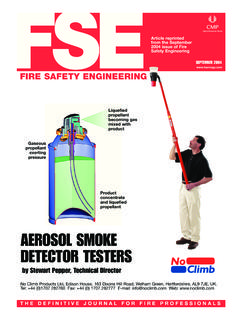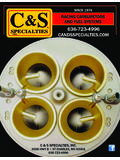Transcription of CYANIDES, aerosol and gas 7904
1 CYANIDES, aerosol and gas7904 HCN and salts MW: (HCN); CAS: 74-90-8 (HCN); RTECS: MW6825000 (HCN); (KCN) 151-50-8 (KCN) TS8750000 (KCN)METHOD: 7904, Issue 2 EVALUATION: FULLI ssue 1: 15 February 1984 Issue 2: 15 August 1994 OSHA :11 mg/m3; skin (HCN) 5 mg/m3; skin (cyanides, as CN-)NIOSH:C 5 mg/m3/10 min (as CN-)ACGIH:C 11 mg/m3; skin (HCN); 5 mg/m3; skin (cyanides, as CN)PROPERTIES: HCN: gas, BP 26 C; VP 620 mm Hg 20 C; vapor density (air = 1); KCN: solid, d g/mL, MP 634 CSYNONYMS:HCN: hydrocyanic acid, prussic acid, formonitrile, :FILTER + BUBBLER( m PVC membrane+ 15 mL N KOH) [1]FLOW to 1 L/minVOL-MIN: 10 L @ mg/m3 (as CN-) -MAX:180 L @ 11 mg/m3 (as CN-)SHIPMENT:routineSAMPLE STABILITY:analyze within 5 days;particulate on filter mayliberate HCN gas [2]BLANKS:2 to 10 field blanks per setMEASUREMENTTECHNIQUE:ION-SPECIFIC ELECTRODEANALYTE: cyanide ion (CN-)EXTRACT FILTER:25 mL N KOH; 30 minRINSEBUBBLER:2 mL N KOH; dilute to 25 mLwith N KOHMEASURE:mV reading of cyanide ion electrodeCALIBRATION:solutions of KCN in N to 2 mg CN-ESTIMATED g CN- [2]PRECISION (S r) (HCN) [3]; (KCN) [2]ACCURACYRANGE STUDIED:5 to 21 mg/m3 (HCN) [3].
2 To 10 mg/m3 (KCN) [2]BIAS:- PRECISION (S rT): (HCN) [3]; (KCN) [2]ACCURACY: : The working range (as CN-) is to 15 mg/m3 for a 90-L air sample or 5 to 20 mg/m3 for a 10-L air : Sulfide, chloride, iodide, bromide, cadmium, zinc, silver, nickel, cuprous iron and mercury interfere. In humidatmospheres, some particulate cyanide collected on the filter will liberate hydrogen cyanide which will be trapped in the bubbler[2]. The method cannot distinguish between HCN formed in this manner and HCN originally present in METHODS: This method combines and replaces Methods S288 [4], S250 [5], and P&CAM 116 [6]. Method 6010(Hydrogen cyanide ) uses a soda lime tube as sampler, with colorimetric Manual of Analytical Methods (NMAM), Fourth Edition, 8/15/94 CYANIDES, aerosol and gas: METHOD 7904, Issue 2, dated 15 August 1994 - Page 2 of 4 cyanide .
3 * stock solution, 1000 g/mL g KCN in N KOH to make100 mL solution. Stable for at least 1 week inpolyethylene hydroxide (KOH), N. g KOH in deionized water; dilute to acetate carbonate (if sulfide present). peroxide, 30% (if sulfide present). sulfite, 1 M (if sulfide present).*See SPECIAL : : polyvinyl chloride membrane filter,37-mm diameter, m pore size in 2-piecefilter cassette holder, followed by a glassmidget bubbler containing 15 mL N KOH. sampling pump, to 1 L/min, withsplashover protection and flexible connectingtubing. , polyethylene, with screw caps, 20-mL,and plastic tape for sealing. ion electrode, (Orion 94-06 orequivalent). electrode. meter, readable to mV. stirrer and stirring bars. , ointment, 60-mL, squat-form withaluminum-lined screw caps.
4 , to 2 and 25-mL, with pipet flasks, , balance, readable to PRECAUTIONS: Hydrogen cyanide gas and the cyanide particulates may be fatal ifswallowed, inhaled or absorbed through the skin. Work in a nitrite is the antidote for cyanide poisoning [7]. each personal sampling pump with a representative sampler in at to 1 L/min for a total sample size of 10 to 180 :Maintain bubblers in a vertical position during sampling. Do not allow the solution levelto fall below 10 the bubbler stem and tap it gently against the inside wall of the bubbler. Rinse thebubbler stem with 1 to 2 mL of unused N KOH. Add the rinse to the transfer the contents of the bubbler to a 20-mL vial. Close cap tightly and wrapwith plastic tape to avoid sample loss during transit.
5 Label each the filter from the cassette filter holder to a 60-mL ointment mL N KOH into the jar. Cap and allow to stand for at least 30 min withoccasional shaking to complete extraction. Analyze within 2 h after the contents of the vial into a 25-mL volumetric flask using N KOH to rinse the vial. Add rinse to the volumetric flask. Dilute to the mark with N :Sulfide ion irreversibly poisons the cyanide ion specific electrode and must be removedif present. Check for the presence of sulfide ion by touching a drop of sample to apiece of lead acetate paper; the paper will discolor in the presence of sulfide ion. If thistest is positive, remove sulfide by one of the following 1 mL 1 M H2O2 and 1 mL 1 M Na2SO3 to sample solutions prior to diluting to volume. NIOSH Manual of Analytical Methods (NMAM), Fourth Edition, 8/15/94 CYANIDES, aerosol and gas: METHOD 7904, Issue 2, dated 15 August 1994 - Page 3 of a small amount (spatula tip) of powdered cadmium carbonate to the sample.
6 Swirl todisperse the solid and recheck the liquid with lead acetate paper. If sulfide ion has not beenremoved completely, add more cadmium carbonate. Avoid a large excess of cadmiumcarbonate and long contact time with the solution. When a drop of liquid no longer discolorsa strip of lead acetate paper, filter the sample through a small plug of glass wool in aPasteur pipette and proceed with the AND QUALITY at least six working standards fresh daily to cover the range 50 to 2000 g CN- persample by diluting aliquots of 1000 g/mL calibration stock solution with N KOH ( , mL calibration stock solution diluted to 25 mL). the working standards according to steps 11 and 12 together with the samples a calibration graph on semilog paper by plotting cyanide ion concentration on thelogarithmic axis and mV on the linear the solution to be measured to a 50-mL beaker.
7 Immerse the cyanide ion electrodeand reference electrode in the sample and start the magnetic the magnetic stirrer on, allow the potential reading to stabilize. Record the mV 1: Potential readings are a function of temperature. Measure samples and workingstandards at the same temperature ( 2 C).NOTE 2: The cyanide electrode will malfunction if chloride, iodide and bromide ions, which forminsoluble silver salts, are present in sufficient quantity. Several metal ions are alsoknown to complex with cyanide such as cadmium, zinc, silver, nickel, cuprous iron andmercury. Consult the electrode instruction manual for the procedure to use when suchions are the mass, g, of cyanide ion present in the sample filter (Wf), sample bubbler (Wb),average media blank filter (Bf) and media blank bubblers (Bb) from the calibration the concentration (mg/m3) of particulate cyanide , Cp, and hydrogen cyanide , CHCN, inthe air volume sampled, V (L):where is the stoichiometric conversion factor from CN- to :Particulate cyanides will be collected on the filter.
8 In humid atmospheres, however, ithas been observed that during the collection of particulate cyanide , HCN is graduallyliberated [2]; therefore, particulate cyanide interference is not completely OF METHOD:HCN: Method S288 was issued on September 2, 1977 [4]. Test atmospheres of HCN were generatedby calibrated flow from a compressed mixture of HCN in nitrogen [3,8]. The range of HCNconcentrations in air was 5 to 21 mg/m3 for 12-L air samples. Eighteen HCN samples collected at for 60 min indicated overall precision of , with a recovery. An eight-day storageNIOSH Manual of Analytical Methods (NMAM), Fourth Edition, 8/15/94 CYANIDES, aerosol and gas: METHOD 7904, Issue 2, dated 15 August 1994 - Page 4 of 4stability study involving six samples at the OSHA standard concentration level indicated a recovery for the one-day old samples and a for eight-day old samples.
9 A collectionefficiency study at twice the OSHA standard level, which included backup bubblers, indicated that anaverage of of HCN was collected in the first bubbler. The HCN air generated concentrationswere independently confirmed by a titration method [3].KCN: Method S250 was issued on January 30, 1976 [5]. A set of six weighed KCN samples in therange of to mg KCN per filter indicated a 97% recovery and a measurement precision [2]. Spiking with aqueous or basic solutions of KCN proved unsuccessful (low recovery) because of thecyanide instability in the presence of water and CO2. Test atmospheres of KCN were generated byatomization of an aqueous solution (162 g/L) of KCN into a dry airstream. Eighteen KCN samplescollected in N NaOH at L/min for 60 min indicated overall precision, S rT, of Collection wasaccomplished with cellulose ester membrane filters followed with backup bubblers.
10 The collectionefficiency at twice the OSHA level was on the filters. cyanide salts are known to decompose inmoist air with liberation of HCN. This instability was determined with two sets of six samples at the oneand two times the OSHA level. Each of the samples which were twice the OSHA level were connectedwith two backup bubblers. Both sets indicated a loss of :[1]Perkins, , Tharr, J. Palassis, Fannin, and Eller, Case Studies: Reduction ofBlank Values in the Determination of Particulate Cyanides. Appl. Occup. Environ. Hyg. 5:836-837(1990).[2]Documentation of the NIOSH Validation Tests, S250, Department of Health, Education, andWelfare, Publ. (NIOSH) 77-185 (1977).[3]Backup Data Report for Hydrogen cyanide , S288, available as "Ten NIOSH Analytical Methods, Set5," Order No.

















